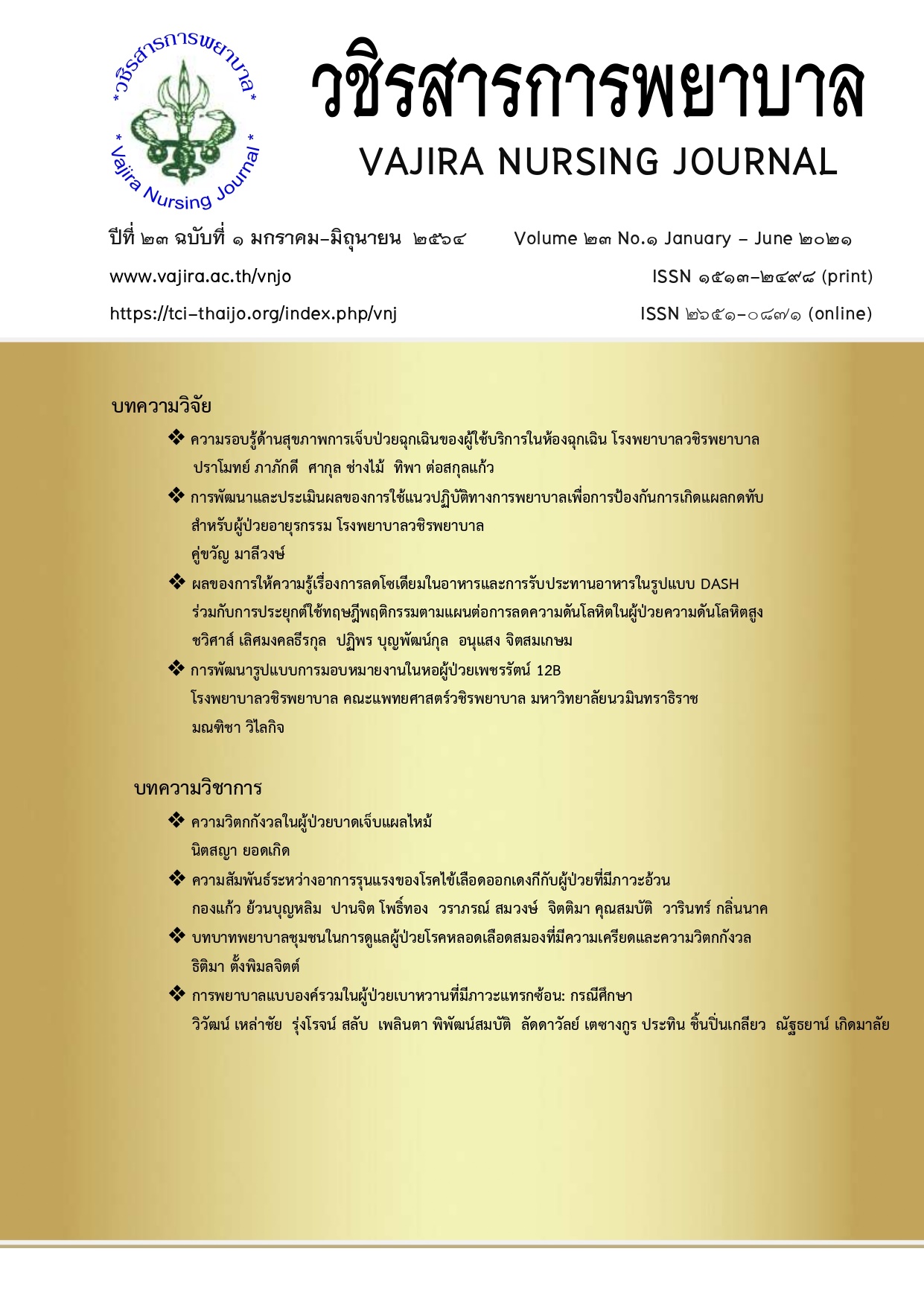ความรอบรู้ด้านสุขภาพการเจ็บป่วยฉุกเฉินของผู้ใช้บริการในห้องฉุกเฉิน โรงพยาบาลวชิรพยาบาล
Main Article Content
บทคัดย่อ
การวิจัยเชิงพรรณนานี้มีวัตถุประสงค์เพื่อศึกษาความรอบรู้ด้านสุขภาพการเจ็บป่วยฉุกเฉินของผู้ใช้บริการในห้องฉุกเฉินโรงพยาบาลวชิรพยาบาล และเปรียบเทียบความรอบรู้ด้านสุขภาพจำแนกตามข้อมูลส่วนบุคคล กลุ่มตัวอย่างคือผู้ป่วยและญาติ จำนวน 440 คน คัดเลือกตัวอย่างแบบสุ่มอย่างง่าย เครื่องมือการวิจัย
คือแบบประเมินข้อมูลส่วนบุคคลของผู้ใช้บริการห้องฉุกเฉินและแบบประเมินความรอบรู้ด้านสุขภาพการเจ็บป่วยฉุกเฉิน เครื่องมือผ่านการตรวจความตรงตามเนื้อหาได้ค่าดัชนีความตรงตามเนื้อหาเท่ากับ .81 และค่าความเที่ยงเท่ากับ .93 วิเคราะห์ข้อมูลด้วยสถิติเชิงพรรณนา Mann-Whitney U test และ Kruskal -Wallis H Test
ผลการวิจัย พบว่า ความรอบรู้ด้านสุขภาพในภาพรวมอยู่ในระดับสูง เมื่อพิจารณารายด้าน พบว่าด้านการเข้าถึงข้อมูลสุขภาพและด้านการประเมินข้อมูลสุขภาพอยู่ในระดับสูงมาก ด้านการเข้าใจข้อมูลสุขภาพอยู่ในระดับสูง และด้านการประยุกต์ใช้ข้อมูลสุขภาพอยู่ในระดับปานกลาง ส่วนการประยุกต์ใช้ข้อมูลสุขภาพรายข้อมีคะแนนอยู่ในระดับต่ำถึงปานกลาง ได้แก่ ข้อคำถามเกี่ยวกับการช่วยเหลือเบื้องต้นผู้ที่มีอาการชักผู้ที่มีอาการของโรคหลอดเลือดสมอง การนำส่งผู้ป่วยด้วยรถส่วนตัว และการใช้สิทธิได้ทุกที่ในกรณีเจ็บป่วยฉุกเฉิน (Universal Coverage for Emergency Patients: UCEP) ผลการเปรียบเทียบคะแนนความรอบรู้ด้านสุขภาพจำแนกตามข้อมูลส่วนบุคคล พบว่า มีความแตกต่างกันของคะแนนความรอบรู้ด้านสุขภาพการเจ็บป่วยฉุกเฉินในกลุ่มญาติผู้ป่วยและผู้ป่วย กลุ่มที่มีประสบการณ์ฝึกอบรมและที่ไม่มีประสบการณ์ฝึกอบรม ระดับการศึกษา อาชีพและรายได้อย่างมีนัยสำคัญทางสถิติที่ระดับ .05 ข้อเสนอแนะจากการวิจัยครั้งนี้ พยาบาลควรนำประเด็นความรอบรู้ด้านสุขภาพการเจ็บป่วยฉุกเฉินรายข้อที่มีคะแนนต่ำไปส่งเสริมความรอบรู้ให้กับประชาชนต่อไป
Article Details

อนุญาตภายใต้เงื่อนไข Creative Commons Attribution-NonCommercial-NoDerivatives 4.0 International License.
เนื้อหาและข้อมูลในบทความที่ลงตีพิมพ์ในวชิรสารการพยาบาลถือเป็นข้อคิดเห็นและความรับผิดชอบของผู้เขียนบทความโดยตรง ซึ่งกองบรรณาธิการไม่จำเป็นต้องเห็นด้วย หรือร่วมรับผิดชอบใด ๆ ทั้งสิ้น
บทความ ข้อมูล เนื้อหา รูปภาพ ฯลฯ ที่ได้รับการตีพิมพ์ในวชิรสารการพยาบาล ถือเป็นลิขสิทธิ์ของวชิรสารการพยาบาล หากบุคคลใดหรือหน่วยงานใดต้องการนำทั้งหมดหรือส่วนหนึ่งส่วนใดไปเผยแพร่ต่อหรือเพื่อกระทำการใด ๆ จะต้องได้รับอนุญาตเป็นลายลักอักษรจากวชิรสารการพยาบาลก่อนเท่านั้น
เอกสารอ้างอิง
กระทรวงสาธารณสุข. (2559). แผนพัฒนาสุขภาพแห่งชาติ ฉบับที่ 12 พ.ศ. 2560-2564. นนทบุรี: กระทรวงสาธารณสุข.
กองสุขศึกษา กรมสนับสนุนบริการสุขภาพ กระทรวงสาธารณสุข. (2554). ความฉลาดทางสุขภาพ. กรุงเทพฯ: นิวธรรมดาการพิมพ์.
คณะกรรมการการแพทย์ฉุกเฉิน. (2553). แผนหลักการแพทย์ฉุกเฉินแห่งชาติ ปี 2553-2555. สืบค้นเมื่อวันที่ 20 เมษายน 2562 จาก https://www.niems.go.th.
ณิชชาภัทร ขันสาคร, ทัศนีย์ ศิลาวรรณ, ทัศนีย์ รวิวรกุล, วิริณธิ์ กิตติพิชัย และอุมาวดี เหลาทอง. (2559). การศึกษาระบบบริการการแพทย์ฉุกเฉินสำหรับผู้สูงอายุ (รายงานการวิจัย). นนทบุรี: สถาบันการแพทย์ฉุกเฉินแห่งชาติ.
ธงชัย อามาตยบัณฑิต, นิพนธ์ มานะสถิตพงศ์, อินทนิล เชื้อบุญชัย, เสาวนีย์ โสบุญ และบดินทร์ บุณขันธ์. (2560). การทบทวนวรรณกรรมอย่างเป็นระบบ: ปัจจัยที่เกี่ยวข้องกับการใช้บริการในระบบการแพทย์ฉุกเฉินก่อนถึงโรงพยาบาล. วารสารวิจัยระบบสาธารณสุข, 11(1), 37-46.
พระราชบัญญัติการแพทย์ฉุกเฉิน พ.ศ. 2551. (2551, 6 มีนาคม). ราชกิจานุเบกษา. เล่ม 125 ตอนที่ 44 ก 131 ง หน้า 1-17.
สถาบันการแพทย์ฉุกเฉินแห่งชาติ. (2554). แนวทางการกำหนดนิยามการเจ็บป่วยฉุกเฉิน. สืบค้นเมื่อวันที่ 20 เมษายน 2562 จาก https://www.niems.go.th.
สถาบันการแพทย์ฉุกเฉินแห่งชาติ. (2556). เกณฑ์วิธีการคัดแยกและจัดลำดับการจ่ายงานบริบาล ผู้ป่วยฉุกเฉิน ตามหลักเกณฑ์ที่ กพฉ. กำหนด พ.ศ. 2556. นนทบุรี: สถาบันการแพทย์ฉุกเฉินแห่งชาติ.
สมาคมเวชศาสตร์ฉุกเฉิน. (2560). คู่มือปฏิบัติการฉุกเฉินนอกโรงพยาบาลสำหรับชุดปฏิบัติการทุกระดับ. นนทบุรี: สถาบันการแพทย์ฉุกเฉินแห่งชาติ.
สัมฤทธิ์ ศรีธำรงสวัสดิ์, ไพบูลย์ สุริยะวงศ์ไพศาล และพงศกร อธิกเศวตพฤทธิ์. (2561). ประสบการณ์ของผู้ป่วยที่ใช้บริการในโรงพยาบาลเอกชนนอกเครือข่ายระบบประกันสุขภาพภาครัฐและขอใช้สิทธิ์ “เจ็บป่วยป่วยฉุกเฉินวิกฤต มีสิทธิ์ทุกที่ (UCEP)”. วารสารวิจัยระบบสาธารณสุข, 12(3), 370 – 403.
สุรภา ขุนทองแก้ว. (2562). การศึกษาปัจจัยที่มีความสัมพันธ์ต่อการใช้บริการการแพทย์ฉุกเฉินจังหวัดราชบุรี. วารสารวิทยาลัยพยาบาลพระจอมเกล้า จังหวัดเพชรบุรี, 2(1), 30-44.
อุมารินทร์ คำพูล, บวร วิทยชำนาญกุล, บริบูรณ์ เชนธนากิจ และกรองกาญจน์ สุธรรม. (2563). ความเข้าใจของประชาชนต่อการคัดแยกระดับความความรุนแรงของการเจ็บป่วยฉุกเฉินของผู้ป่วยก่อนถึงโรงพยาบาล. วารสารวิจัยระบบสาธารณสุข, 14(2), 197-207.
Banfai-Csonka, H., Banfai, B., Jeges, S., Gyebnar, B. & Bethehem, J. (2020). Health literacy among participants from neighborhoods with different socioeconomic statuses in the southern region of Hungary: a pilot study. BMC Public Health, 20(Suppl 1), 1-8.
Raun, L.H., Ensor, K. B., Campus, L.A., & Persse, D. (2015). Factors affecting ambulance utilization for asthma attack treatment: understanding where to target interventions. Public Health. (129), 501-8.
Sorensen, K., Van den Broucke, S., Fullam, J., Doyle, G., Pelikan, J., Slonska, Z. & Brand, H. (2012). Health literacy and public health: A systematic review and integration of definitions and models. BMC Public Health, 12(80), 1-13.
Toloo, G-S., Aitken, P., Crilly, J., FitzGerald, G. (2016). Agreement between triage category and patient’s perception of priority in emergency departments. Scandinavian Journal of Trauma, Resuscitation and Emergency Medicine, 24(126), 1-8.
World Health Organization. (1998). Health promotion glossar (p.10). Geneva: World Health Organization Publications.
World Health Organization. (2007). The world health report 2007: a safer future: global public health security in the 21st century (p.62-65). Geneva: World Health Organization Publications.
Yamane, T. (1973). Statistics: An introductory analysis (p.727-728) (3rd ed.). New York: Harper and Row Publications.


